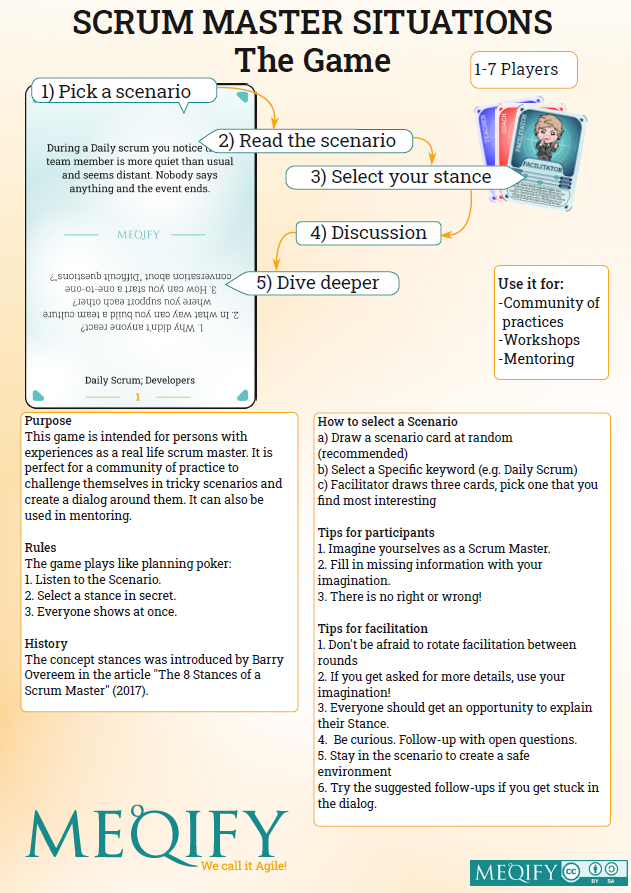Scrum Master Situations – The Game
Game based on the concepts that a Scrum Master must take different stances in different situations
Purpose
This game is intended for persons with experiences as a real life scrum master. It is perfect for a community of practice to challenge themselves in tricky scenarios and create a dialog around them. It can also be used in mentoring.
How-to-Play
1. Pick a scenario
Pick one of 40+ scenario cards and read it out loud:
During a Daily Scrum you notice that a team member is more quiet than usual and seems distant. Nobody says anything and the event ends.
2. Select your stance
Imagine how you would react in the situation and secretly select one of the 7 stances to reflect that.
3. Discuss
Show your stances at once and discuss differences and similarities in your different approaches.
4. Dive deeper
If you get stuck, or want to go deeper in the subject, you can turn the card around and read some prompts:
1. Why didn’t anyone react?
2. In what way can you build a team culture where you react?
3. How can you start a one-to-one conversation about ”Difficult questions”?
Material needed
Download links to the game and additional resources are available for free to the left. You can buy a physical copy at academy.meqify.se
All material is released under CC-BY SA license. This means you can use it however you like (including commercial) but there must always be a refrence to MEQIFY. If you create versions of the game, you must release it under the same licence.
Rules
The game plays like planning poker:
- Listen to the Scenario.
- Select a stance in secret.
- Everyone shows at once.
You can select a scenario in different ways:
- Draw a scenario card at random (recommended).
- Select a Specific keyword (e.g. Daily Scrum).
- Facilitator draws three cards, pick one that you find most interesting.
Tips
Pre-reading:
- https://www.scrum.org/resources/8-stances-scrum-master
- https://less.works/blog/2019/12/16/actively-doing-nothing.html
- https://www.comicagile.net/comic/anatomy-of-an-agile-coach/
For participants
- Imagine yourselves as a Scrum Master.
- Fill in missing information with your imagination.
- There is no right or wrong!
For facilitation
- Don’t be afraid to rotate facilitation between rounds.
- If you get asked for more details, use your imagination!
- Everyone should get an opportunity to explain their Stance.
- Be curious. Follow-up with open questions.
- Stay in the scenario to create a safe environment.
- Try the suggested follow-ups if you get stuck in the dialog.
History
The concept stances was introduced by Barry Overeem in the article ”The 8 Stances of a Scrum Master” (2017), and build on by Comic Agilé and LeSS. Links to the left.




